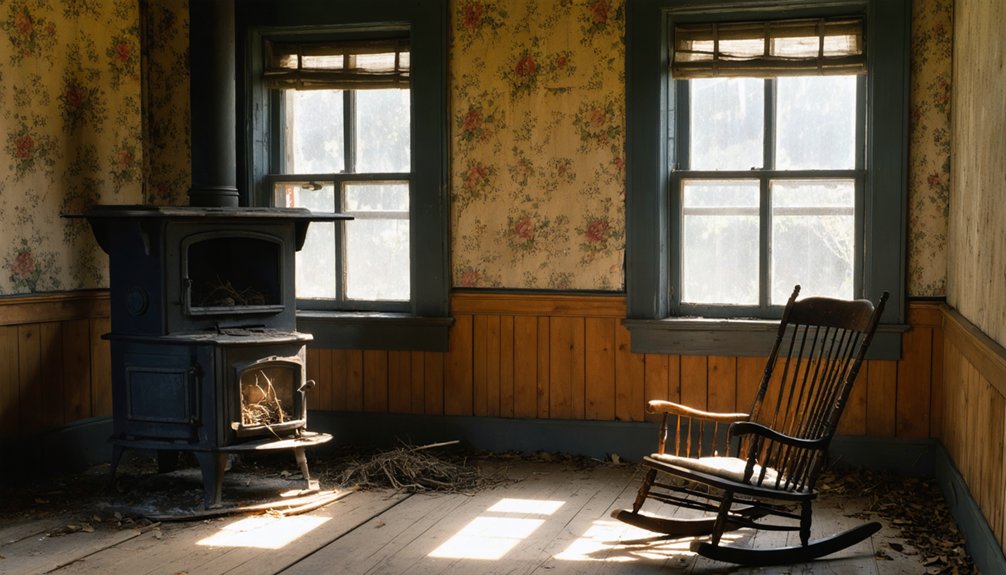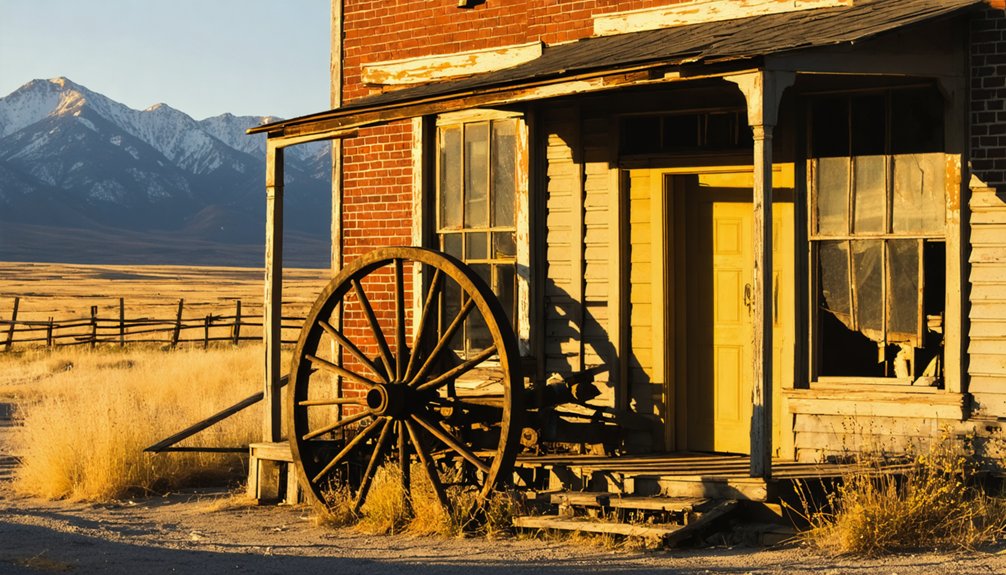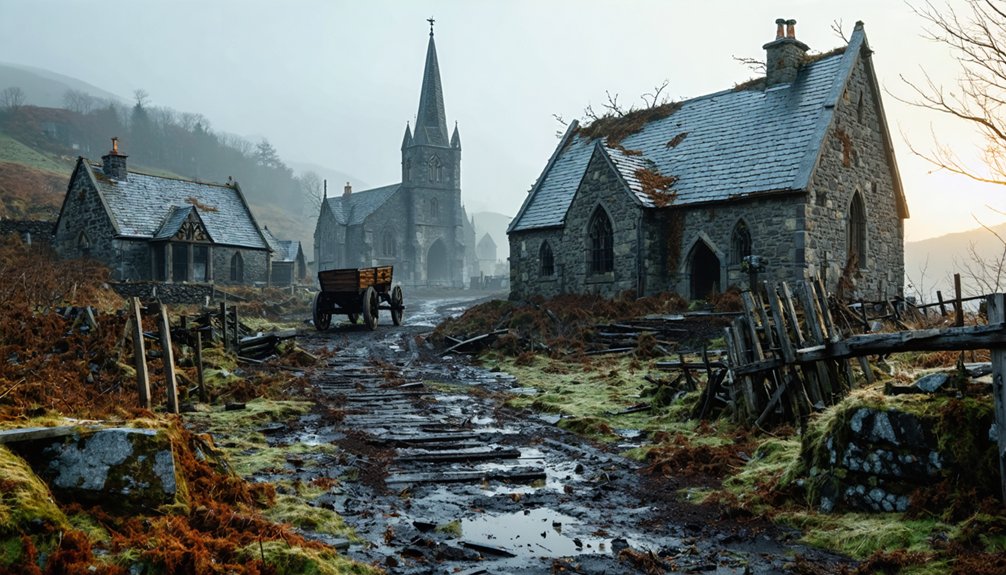Victoria’s abandoned gold mining towns offer windows into Australia’s dramatic 1850s rush that produced one-third of the world’s gold. You’ll discover Welsh cultural enclaves, architectural evolution from tents to mansions, and ghost towns like Walhalla and Talbot. Visit heritage trails at Bendigo’s Victoria Hill Mining Reserve or photograph industrial ruins at Jubilee Mine. The preserved Welsh chapels and mining structures reveal stories of prosperity, diversity, and eventual decline across the Victorian countryside.
Key Takeaways
- Victorian gold rush created numerous mining towns that are now abandoned yet rich in historical significance and photographic opportunities.
- Visit ghost towns like Walhalla, Talbot, and Amherst to see preserved structures that tell stories of once-thriving communities.
- Follow heritage trails such as Steiglitz Town Walk and Bendigo’s Victoria Hill Mining Reserve for guided exploration of mining history.
- Best visiting time is late spring through early fall, with May-June offering wildflowers and September providing warm days with fewer crowds.
- Bring sturdy hiking boots, layered clothing, and quality camera equipment when exploring these historic abandoned sites.
The Rise and Fall of Victoria’s Golden Era

When gold was officially discovered at Clunes in Victoria in 1850, few could have anticipated the seismic economic and social transformation that would soon engulf the newly formed colony.
The discovery at Clunes in 1850 ignited a transformation that would forever alter Victoria’s destiny.
Within years, Victoria became the epicenter of a global gold rush, producing over one-third of the world’s gold during the 1850s.
You’ll find the economic impact of this golden era etched into the landscape—abandoned towns once teeming with tens of thousands of prospectors who arrived weekly to Ballarat and Bendigo.
Surface gold mining quickly evolved from simple panning to industrial-scale operations as easily accessible deposits depleted. By 1856, the colony reached its peak gold yield of over 3 million troy ounces, transforming the remote dependency into a globally recognized region.
The goldfields’ population became remarkably diverse with Chinese immigrants numbering over 38,000 by 1861, though they often faced discrimination and violence in mining communities.
Must-Visit Ghost Towns With Rich Mining Heritage
While Melbourne’s grand Victorian architecture displays the wealth generated during the gold rush, it’s the abandoned mining towns scattered across the state that truly reveal the human stories behind this transformative period.
You’ll discover Walhalla, where ghost town legends persist among the billion-dollar gold legacy and cultural institutions that once supported 4,000 residents.
Talbot offers meticulously preserved structures from when 30,000 people and 100 hotels occupied this central Victorian settlement.
At Amherst, Chinese baths carved into the earth evidence the multicultural mining folklore that shaped these communities.
Timor’s wide bluestone kerbs recall its eight-coach boomtown prosperity, while Llanelly and Tarnagulla preserve Welsh heritage alongside Victorian-era architecture. The impressive stone arch remains at Grand Duke Mine provide a striking reminder of the once-bustling industrial activity that defined these communities.
These settlements—with their abandoned mines, mullock heaps, and bluestone culverts—provide unparalleled access to the authentic goldfields experience, beyond sanitized historical accounts. Visitors can explore the Garfield Water Wheel site with its massive stone abutments that once supported a 22-meter diameter wheel used to power mining operations from 1887 to 1903.
Walking Through History: Top Heritage Trails

The remnants of Victoria’s gold rush era extend beyond the preserved ghost towns into the landscape itself, where a network of carefully documented heritage trails now invites visitors to experience mining history through direct engagement with historical sites.
You’ll discover exceptional examples of mining technology at Jubilee Mine and Staffordshire Reef, where battery foundations and water races reveal industrial ingenuity.
The Steiglitz Town Walk guides you through a half-hour circuit of gold rush architecture, while Bendigo’s Victoria Hill Mining Reserve features extensive tracks past meticulously interpreted ruins.
For understanding quartz-mining processes, Eureka Reef near Chewton offers 21 heritage walk points amid settlement remnants.
These trails represent successful heritage conservation efforts, preserving engineering marvels like the 22-meter Garfield Water Wheel supports and cyanide works that defined Victoria’s industrial development. Visitors can explore similar historical significance along Cornwall’s Great Flat Lode Trail, which follows the former Basset Mine Tramway used for transporting tin ore. The charming town of Walhalla provides immersive experiences through its popular ghost tours that bring the mining era’s stories to life.
Architectural Treasures of the Gold Rush Period
From hastily erected canvas shelters to ornate Victorian mansions, the architectural evolution in gold rush settlements reveals perhaps the most tangible expression of wealth transformation in Australia’s mining districts.
The humble tent to the grand mansion—architecture chronicling the metamorphosis of mining wealth across Australia’s gold fields.
You’ll witness this progression through three distinct phases: tent encampments with sod chimneys, intermediate hybrid structures, and finally, the elaborate Boom style edifices that define Victorian architecture in these towns.
As you explore Bendigo or Ballarat, note how mining aesthetics evolved from practical to ornamental.
The narrow buildings with false fronts and decorative façades showcase merchants’ competitive spirit, while mansions like Fortuna demonstrate mining magnates’ ostentatious wealth.
The colonnaded two-story structures weren’t merely decorative—they provided essential shade in treeless landscapes, merging practicality with the period’s decorative sensibilities that still captivate visitors today. The transition to these permanent structures was accelerated when deeper shaft mining techniques required more capital investment and created more stable town populations.
In New Zealand’s historic mining towns like Arrowtown and Cromwell, preserved Victorian streetscapes offer remarkable insights into the lives of early settlers who transformed the rugged wilderness into thriving communities.
Welsh Influence on Victorian Goldfields

As you explore the abandoned mining settlements around Ballarat and Sebastopol, you’ll encounter the distinctive imprint of Welsh immigration patterns, where approximately 50% of Victorian Welsh immigrants concentrated in these goldfields—significantly higher than other British Isles groups.
The tight-knit Welsh communities established recognizable cultural enclaves, introducing eisteddfods and hymn-singing festivals that transformed the social fabric of these mining towns.
Their cooperative mining approaches, rooted in traditional Welsh communal values, proved particularly well-suited to Victoria’s deep lead mining challenges and continue to shape the architectural and cultural remnants you can observe today. These mining techniques were influenced by the multicultural society that formed during the gold rush period when Victoria’s population dramatically increased from 430,000 in 1851 to 1.7 million by 1871. The rebellious spirit that fueled the Eureka Stockade in 1854 is evident in many of the preserved historical sites throughout the region.
Welsh Settlement Patterns
While gold-hungry prospectors from many nations flocked to Victoria’s goldfields during the 1850s, Welsh immigrants established particularly distinctive settlement patterns that transformed the cultural landscape of mining towns like Ballarat and Sebastopol.
You’ll discover that Welsh settlement dynamics followed a recognizable trajectory: initial concentration in cultural enclaves like “The Welsh Village” near Castlemaine, followed by gradual dispersal. Their numbers swelled impressively from 2,326 in 1854 to 6,055 by 1861, creating Australia’s most identifiable Welsh ethnolinguistic community of the period.
However, community integration accelerated through intermarriage, linguistic assimilation, and occupational diversification. Unlike some ethnic groups, the Welsh didn’t maintain exclusive settlements long-term.
As you explore these abandoned mining towns today, you’ll find remnants of Welsh influence gradually blended into the broader Australian cultural fabric.
Cultural Legacy Endures
The cultural legacy of Welsh immigrants endures throughout Victoria’s abandoned mining landscapes, transcending their relatively brief period of concentrated settlement.
As you explore these forgotten towns, you’ll encounter remnants of Welsh chapels that once served as focal points for community cohesion, where non-conformist religious traditions flourished distinctly from Anglican or Catholic practices.
Notice how the Welsh maintained their cultural expressions through eisteddfods and hymn-singing festivals, creating vibrant social events that preserved their language and heritage amidst the diverse goldfield populations.
Their concentrated presence—comprising over 1.6% of goldfield residents—allowed them to establish protective ethnic enclaves like the Welsh Village near Castlemaine.
These communities sustained their identity through chapels, cemeteries, and social institutions that offered both spiritual guidance and practical support networks for miners adapting to their new colonial environment.
Essential Photography Spots for History Buffs
Victorian-era gold rush sites offer unparalleled photography opportunities for history enthusiasts seeking to document Australia’s industrial heritage. When capturing historical photography, prioritize locations that showcase the technological evolution and social context of mining operations.
Through the lens of Victorian gold rush sites, Australia’s mining past emerges in compelling visual narratives of innovation and society.
- Herons Reef, Fryerstown – Photograph the remarkably preserved Cornish miner’s hut, constructed circa 1867 with local stone and mud mortar, representing rare domestic mining architecture.
- Mopoke Gully Water Wheel – Document the stepped masonry abutments amid secluded bushland for compelling industrial archaeological compositions.
- Jubilee Mine – Capture the thorough narrative of industrial mining through battery foundations, engine beds, and cyanide plant ruins.
- Creswick Historic Buildings – Frame the 1862 post office, 1876 town hall, and 1897 bandstand to illustrate how mining wealth transformed rural settlements into sophisticated townships.
Planning Your Gold Country Expedition

Your expedition to Gold Country requires specialized equipment including sturdy hiking boots, layered clothing for variable temperatures, and a high-quality camera with polarizing filters to capture architectural details in changing light conditions.
The ideal traveling window spans late spring through early fall, with May-June offering wildflower displays alongside historic structures and September providing warm days with minimal crowds at abandoned mining sites.
Choosing between heritage accommodations in restored Victorian buildings or camping beneath star-filled skies near ghost towns presents a methodical consideration of immersion versus convenience, with both options offering distinct perspectives on the region’s rich mining legacy.
Equipment For Heritage Exploration
When commencing expeditions to abandoned Victorian mining towns, proper equipment selection becomes not merely a matter of comfort but one of practical necessity and safety. Your essential gear must address the multifaceted challenges of heritage exploration while ensuring protection against environmental hazards inherent to these historical sites.
Your safety checklist should include:
- Protective attire – waterproof outer shells, durable hiking boots with ankle support, and moisture-wicking base layers for temperature regulation.
- Navigation equipment – topographic maps, GPS devices with emergency features, and headlamps for subterranean investigations.
- Specialized tools – sturdy gloves, dust masks, and trekking poles for traversing unstable terrain characteristic of mining ruins.
- Documentation apparatus – cameras, notebooks, and reference materials to catalog historical findings methodically while preserving the integrity of these freedom-inspiring relics.
Best Traveling Seasons
Selecting the ideal season for exploring Victorian mining towns requires strategic consideration of climate patterns, accessibility factors, and cultural events that enhance the historical experience.
Autumn emerges as your prime window, offering mild temperatures, stable weather conditions, and spectacular foliage that frames historic structures beautifully. You’ll benefit from comfortable exploration opportunities without summer crowds.
Spring presents a viable alternative with moderate temperatures and cultural enrichment through the Ballarat Begonia Festival and Bendigo Easter Fair. However, remain vigilant about seasonal considerations like spring’s potential for muddy conditions in bushland areas.
Weather impacts accessibility considerably—winter snow can render roads impassable, while summer heat necessitates strategic timing of your visits to cooler hours, particularly in exposed mining ruins where shade is minimal.
Accommodation Or Camping?
Once you’ve determined the ideal season for your Victorian mining town expedition, the lodging decision becomes a cornerstone of your planning process. Your choice greatly impacts your immersive experience within these historic landscapes.
- Camping considerations – Rustic campgrounds near Woods Point and Walhalla offer proximity to ruins, though facilities remain limited. Prepare for variable weather and fire restrictions.
- Accommodation types – Heritage-listed properties in towns like Maldon provide authentic period experiences with antique furnishings and original architecture.
- Logistical advantages – Staying in serviced towns (Bendigo, Omeo) guarantees access to dining, museums, and guided tours while maintaining a comfortable base.
- Historical immersion – Converted churches and restored gold-era buildings offer unique stays that complement your exploration of abandoned mining heritage.
Preserving the Legacy: Conservation Efforts Today

The preservation of Victoria’s abandoned mining towns represents a complex interplay between legislative frameworks, governmental initiatives, and grassroots activism. Protected under the Heritage Act 2017 and Aboriginal Heritage Act 2006, these sites benefit from structured conservation protocols while facing restoration challenges from weathering and vandalism.
Victoria’s ghost towns survive through an intricate dance of laws, government action, and passionate community defenders.
You’ll find community engagement thriving through local historical societies and volunteer groups who conduct maintenance activities and document oral histories. These grassroots efforts complement work by Heritage Victoria and the National Trust, creating a multi-tiered approach to conservation.
When you explore these historic sites, you’re witnessing a delicate balancing act between preservation and accessibility.
Technological innovations like 3D scanning now document at-risk structures, while sustainable restoration practices employ traditional techniques—ensuring these tangible connections to Victoria’s mining heritage endure for future generations.
Frequently Asked Questions
Are Abandoned Mine Shafts Dangerous to Explore?
Yes, you’re risking death in abandoned mine shafts. Despite their historical significance, they present lethal hazards requiring extensive safety precautions—structural collapse, hidden shafts, toxic gases, and wildlife threats await the unprepared.
Can I Legally Metal Detect or Fossick in These Areas?
Want true freedom to hunt relics? You generally can’t legally metal detect in these areas without specific fossicking permits. Metal detecting laws strictly prohibit activity in historically protected sites and private properties.
What Wildlife Hazards Should Visitors Be Aware Of?
You’ll encounter large carnivores like mountain lions and bears, venomous rattlesnakes, spiders, and scorpions. Wildlife safety precautions are essential when traversing mines contaminated with heavy metals that affect animal behavior.
Are There Accommodations Available Within These Ghost Towns?
Imagine discovering… most ghost towns lack on-site lodging, but you’ll find historical lodging options in towns like Maldon with heritage-listed accommodations, while others require camping or staying in nearby active communities.
Do Any Descendants of Original Miners Still Live Nearby?
Yes, you’ll encounter many descendants of Cornish and Chinese miners maintaining family connections throughout Victoria’s goldfields. Their continued presence carries profound historical significance for understanding migration’s enduring demographic impact.
References
- https://www.goldfieldsguide.com.au/blog/141/abandoned-mines-to-explore-in-the-victorian-goldfields
- https://hemamaps.com/blogs/iconic-destinations/ghost-towns-of-the-goldfields
- https://www.australiantraveller.com/vic/ghost-towns-in-victoria/
- https://en.wikipedia.org/wiki/Victorian_gold_rush
- https://westernmininghistory.com/map/
- https://www.youtube.com/watch?v=a6sVs84MbOY
- https://www.nma.gov.au/defining-moments/resources/gold-rushes
- https://resources.vic.gov.au/geology-exploration/minerals/metals/gold/gold-mining-in-victoria
- https://www.britannica.com/event/Australian-gold-rushes
- http://stagoldrush.weebly.com/timeline.html



